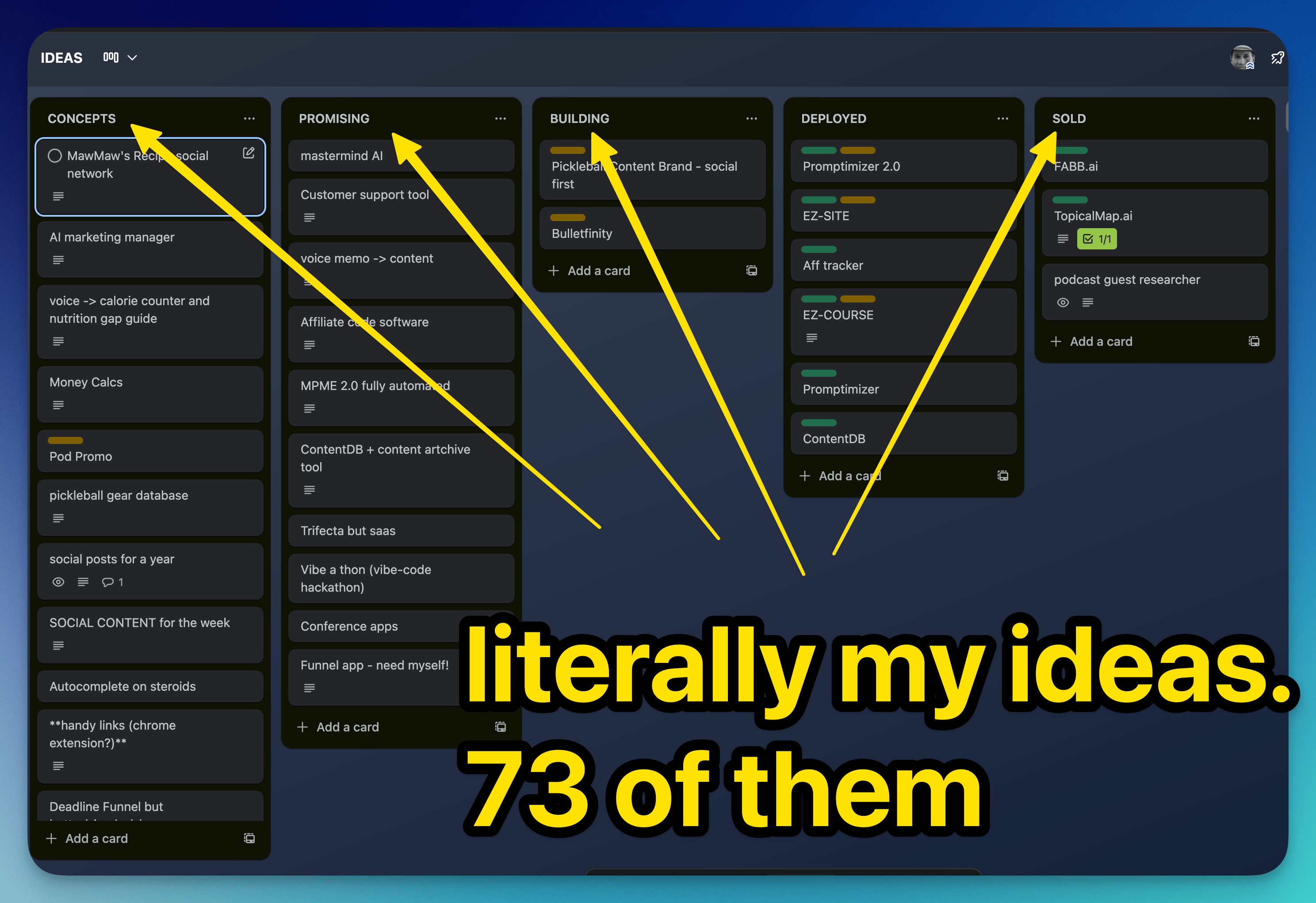How to Come Up With Killer Vibe Coding Ideas

One of the biggest roadblocks for new vibe-coders isn’t the techie AI stuff. It’s not code, frameworks, or debugging nightmares.
It’s having a crystal-clear idea.
An idea that you understand completely—where your first 10 customers will come from, how it’ll make money, and why it’s worth building.
In this post, I’m sharing my exact process for generating tons of app ideas you can develop quickly… even if you’ve never written a line of code.
Video version here 👇
And no, this isn’t just “ask ChatGPT for ideas.” We’re going deeper than that. Methodical. Simple. Practical.
Here’s the plan:
First, I’ll show you a 3-question filter to weed out bad ideas.
Then, we’ll walk through my five favorite idea-generating strategies.
Finally, I’ll share a 100% free tool I built to supercharge this entire process.
The 3-Question Filter for App Ideas
Before you fall in love with any idea, run it through this quick filter.
Where will your first 10 users come from?
If you can’t clearly picture how you’ll reach those first 10 people, move on. Audience comes first.Will it save time or make money?
If it won’t make money, it needs to save you significant time, or make you genuinely happier. No clear benefit? Toss it.Are you excited to work on it?
You don’t need to be obsessed with your idea, but you do need enough excitement to push through inevitable roadblocks.
Run every idea through these three questions. If it doesn’t pass? Move on.
My 5 Favorite Ways to Generate App Ideas
Okay, now that you have a filter, let’s start generating ideas.
1. Scratch Your Own Itch
Start paying attention to your own pain points. Whenever you feel frustration or annoyance, pause and take note.
Example: I once paid $1,000 for a service that took six weeks to deliver results. When it was done, I thought, “Could I just build this myself?” That thought eventually became Topical Map AI—an app I built in three days and later sold for a profit.
Pro Tip: Keep an "idea inbox" in your go-to note taking software, where you can quickly capture ideas as they pop into your head!

Even if no one else ever uses your app, you’ll still solve your own problem.
That alone is worth it.
2. Unbundle Big Apps
Large software companies pack a ton of features into their products. But most users only need one or two of them.
Example: I used Ahrefs, a powerful SEO tool, but only for its “Site Explorer” feature. I would’ve happily paid for a cheaper, standalone version of that tool.
Look at the apps you (or your audience) use. Which ones are bloated or overly complicated? Could you build a simpler app that just focuses on one key feature?
3. Disrupt Overpriced Legacy Apps
Find software that’s been around for 5+ years, built before the AI boom. Many of these are overpriced and ripe for disruption.
Example: Calendly charges $10/month for appointment booking. With vibe coding, you could create a simple alternative in a weekend—and either charge less or offer it free to build an audience.
When using this strategy, avoid ideas that depend on expensive APIs. Focus on apps with low hosting costs that scale easily.
Personal example: I built Bulletfinity.com, a free note-taking app, simply because I didn’t want to pay $10/month for an alternative. It’s not a massive money-maker, but it was fun to build and solved my problem.
4. Document Your Boring Tasks
At the end of each day (or a few times per week), jot down the tasks you completed—especially anything boring or repetitive.
These are goldmines for automation.
Example: I used to manually create timestamps for my YouTube videos. Total time-waster. That’s a perfect candidate for a small, automated app.
Do this for a week or two and you’ll start spotting patterns. Somewhere in that list is a potential app idea.
5. Follow the Money
Go where people are already spending money.
Product Hunt: See what’s trending and why certain products are gaining traction.
AppSumo: Look at what apps people are buying now.
Reddit: Browse niche subreddits or search “boring businesses” for unexpected opportunities.
Facebook Groups: Watch for recurring complaints or requests.
Pro tip: Don’t just copy random ideas. Run them through your 3-question filter first. Can you reach the target audience? Will it save time or make money? Are you excited about it?
The Free Tool I Built for You
Coming up with ideas manually is great—but I wanted to take it one step further.
I built a free tool at codeplaybook.com/idea. Here’s how it works:
Enter your target audience (e.g., music teachers, fitness coaches, etc.).
Choose your preferred tech stack (to make sure ideas are realistic).
Run it in “Deep Research Mode.”
The AI will dig deep into your audience’s pain points and generate a list of potential app ideas. At the end, it gives you a clear summary and highlights its top three recommendations.
Run it as many times as you want. Some ideas might be trash, others might be gems—but this method beats generic AI brainstorming by a mile.
Your Next Step
Idea generation is just the beginning.
If you want to get a beginner overview of vibe coding, I created a FREE 5-day email course here.
Happy vibe coding,
Pete